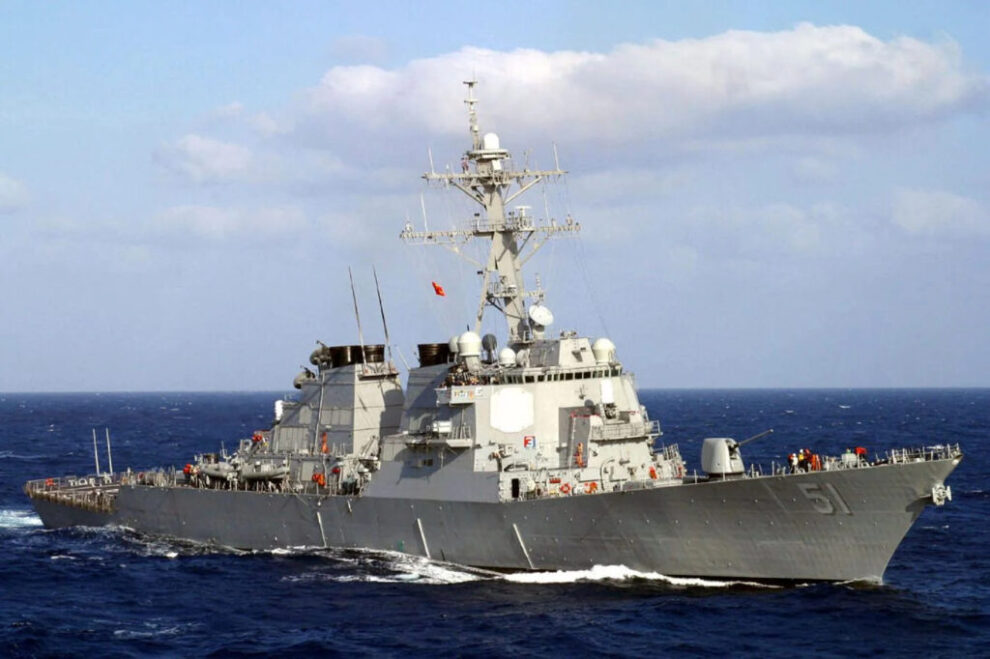A Chinese military think-tank simulated a “total war” with the US, with neither side constrained by deterrence, fears of escalation, and bringing in their full and unrestricted military capacity to bear down on the other.
This was to test how such an extremely political and strategic situation might affect the individual performance of People’s Liberation Army Navy (PLAN) warships, which would face multiple simultaneous threats and would expend or overstretch their anti-ship, anti-land, and electronic warfare capabilities.
The results were catastrophic for the Chinese Navy, with its destroyers losing over half of their combat capability.
However, the paper on the wargame simulation by the PLA’s Unit 91404 at Qinhuangdao does not suggest the Chinese leadership is actively envisaging such a fight or a reflection of such a sentiment in the Communist Party of China (CPC).
Rather it employs the standard military practice of preparing for worst-case scenarios to test the limits of their weapons systems, defense technology, and warfighting doctrine.
Militaries worldwide generally prepare for such doomsday scenarios where they overestimate the enemy. The paper written by Fang Canxin and Guo Xinwang was published in the peer-reviewed Chinese Journal of Ship Research.
The Total War Scenario
Designating the doomsday war as ‘Z,’ the researchers said the fight would “be a clash of strategic willpower (where) the regional conflict escalates to a total war.”
This means a war between the US and China is not restricted to the latter’s invasion of Taiwan but engulfs even the South China Sea (SCS), where Beijing contests maritime boundaries with the Philippines, Indonesia, and Vietnam.
Such a scenario would entail a Chinese destroyer being attacked by over a dozen missiles and three torpedoes. The Blue Alliance – the navy with Arleigh Burke carriers – generated jamming noises over 30 times stronger than the signal used by the ship to communicate.
It also reduced the range of Chinese warships’ radars by 60%. It doesn’t, however, name any country or navy specifically.
How Will Chinese Warships Perform
The paper identifies four scenarios. When the Blue Alliance does not participate in the war either with firepower or with targeting information, the Chinese ship faces only one or two missiles of a single type and one torpedo only once.
This means the US is not defending Taiwan or Japan, fully freeing the PLAN’s hand. It may face only a single anti-ship missile attack from other enemy warships.
When the Blue Alliance provides targetting and reconnaissance data, there is a ‘two-way’ exchange of fire – or both the Chinese destroyer and the enemy ship trading fire. Here both ships launch two waves of five to seven different types of missiles and two torpedoes.
When the Blue Alliance participates directly in the war, both ships exchange nine to eleven different missiles in two waves, and three torpedos are traded in a single wave.
Generally, while engaging an enemy warship, navies and aircraft fire missiles in volleys of at least two to increase the chances of a hit. The same tactic applies to anti-air warfare when crews and pilots fire two missiles at the same aircraft as a pair.
But when the war escalates and “local wars spread to full-scale wars,” the rain of missiles is truly terrifying. Multiple waves of more than 11 different types of missiles and three torpedoes each are exchanged in multiple directions.
According to Fang’s team, these extreme conditions severely curbed the Chinese warship’s combat capabilities.
For instance, almost a third of the destroyer’s air-defense capabilities would be lost immediately after the attack. Only half the surface-to-air missiles could hit the incoming targets.
However, a warship’s fate is negligible to the overall devastation from the war, which would have killed millions while destroying cities, transport systems, communication networks, and industries.
If nuclear weapons are used, the war could permanently destroy ecosystems and agriculture, leading to food shortages, genetic mutations, higher cancer rates, and other diseases.

US Think Tanks Have Done It Too
Interestingly, even US-based think tanks have undertaken similar studies and wargames that have predicted devastating defeats for both the US and Chinese militaries.
The Center for Strategic and International Studies (CSIS) conducted a series of wargames in January this year simulating a Taiwan scenario.
It estimated over 10,000 total US casualties, losing 10-20 warships, two aircraft carriers, 200-400 warplanes, and more than 3,000 troops in three weeks of fighting. China meanwhile lost 90 percent of its amphibious fleet, 52 major surface warships, and 160 warplanes.
In 2020, Pentagon-commissioned wargames by the RAND Corporation concluded devastating US and Taiwanese losses against hordes and floods of Chinese military hardware.
The Red Team (Beijing) swarms the seas around Taiwan with over 300 warships and thousands of cheap, expendable missiles, drones, nearly 10,000 boats, ferries, barrages, fishing craft, and thousands of decoys.
These numbers would be too overwhelming for Taiwan and a few dozen US submarines and warships with no Long-Range Anti-Ship Missiles (LRASM).
Source : eurasiantimes










